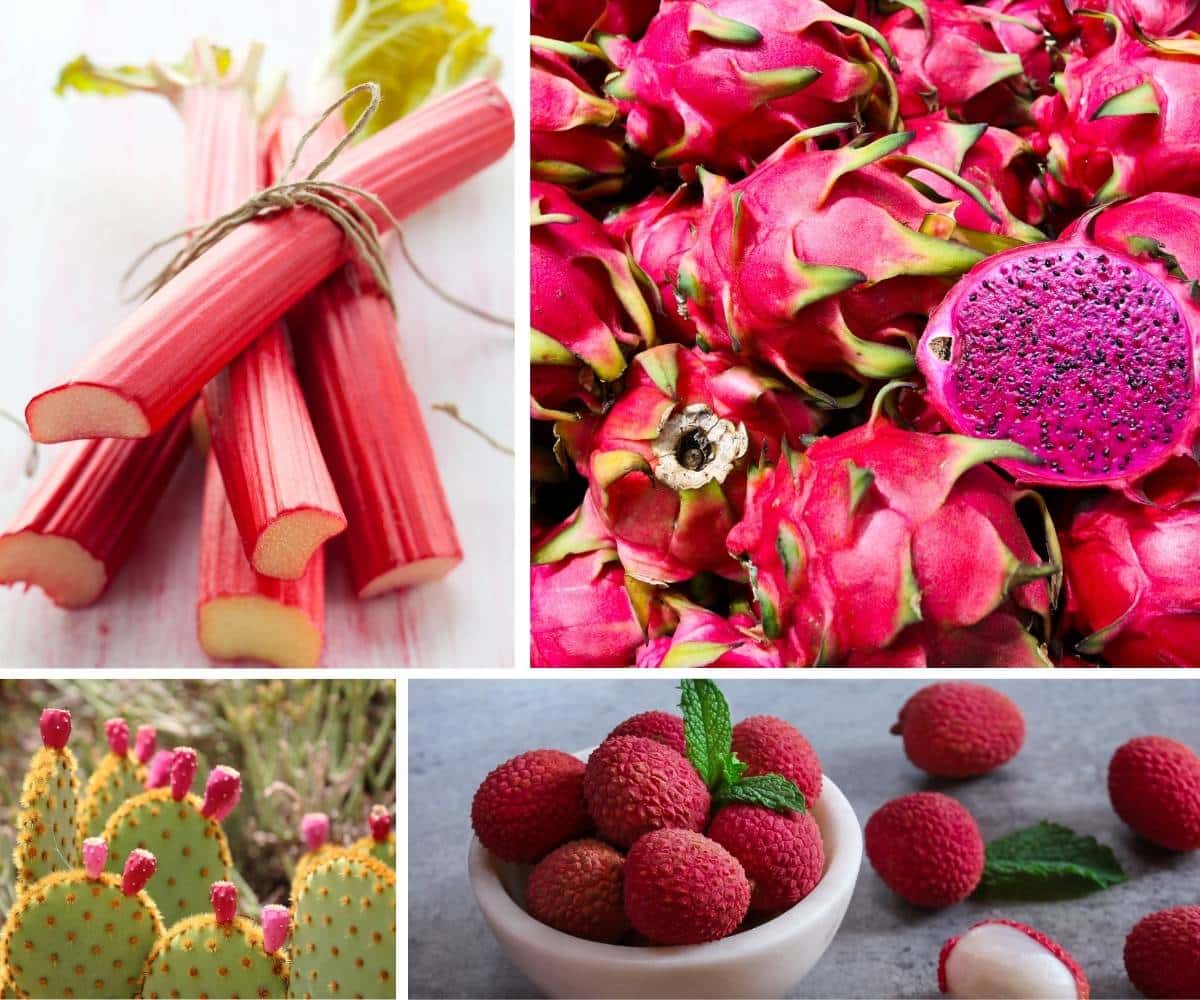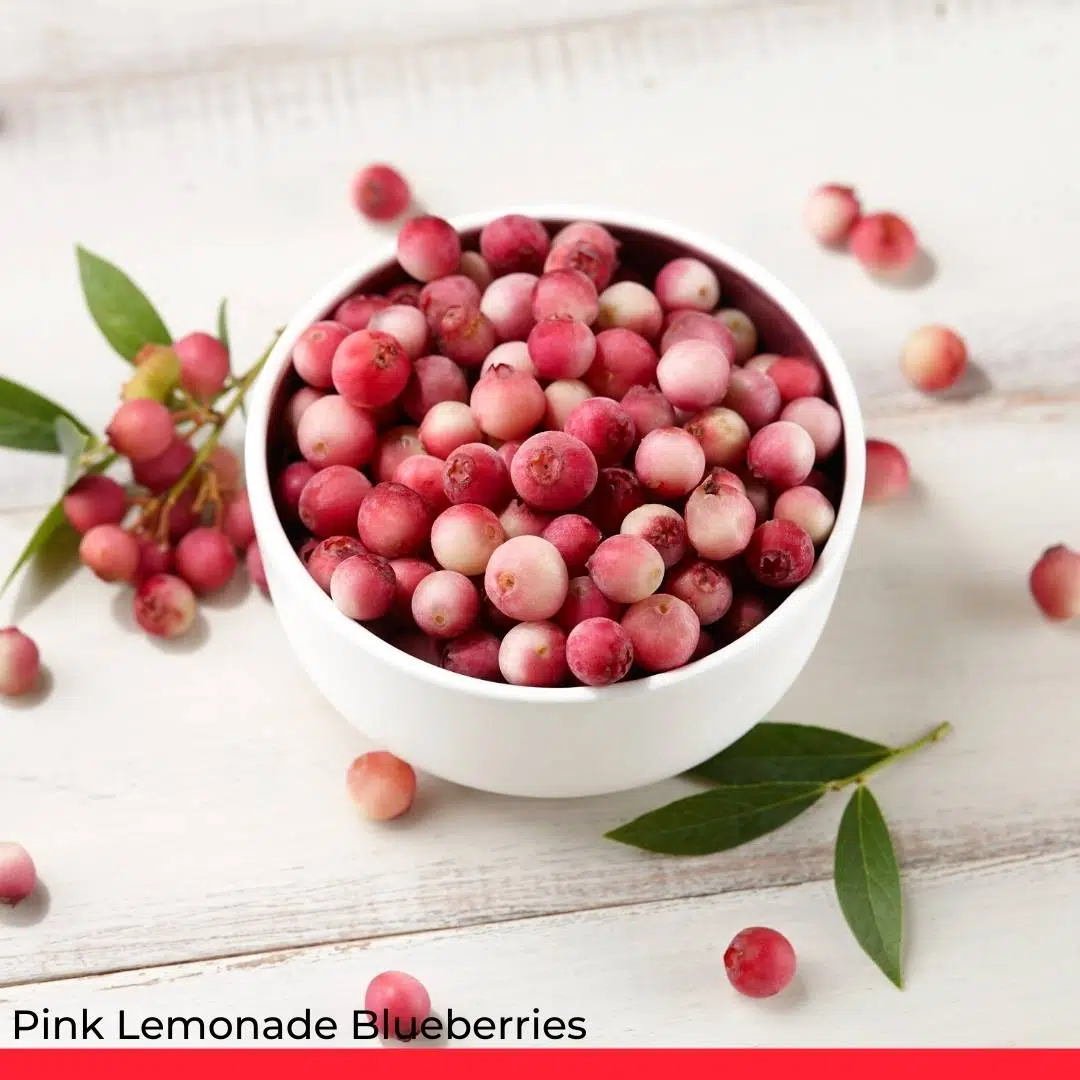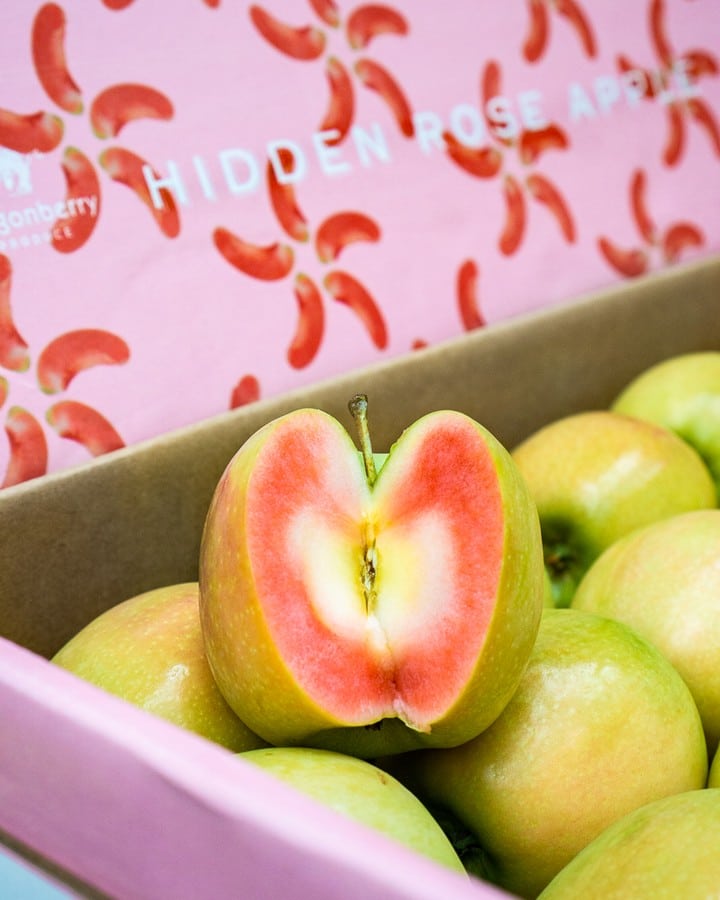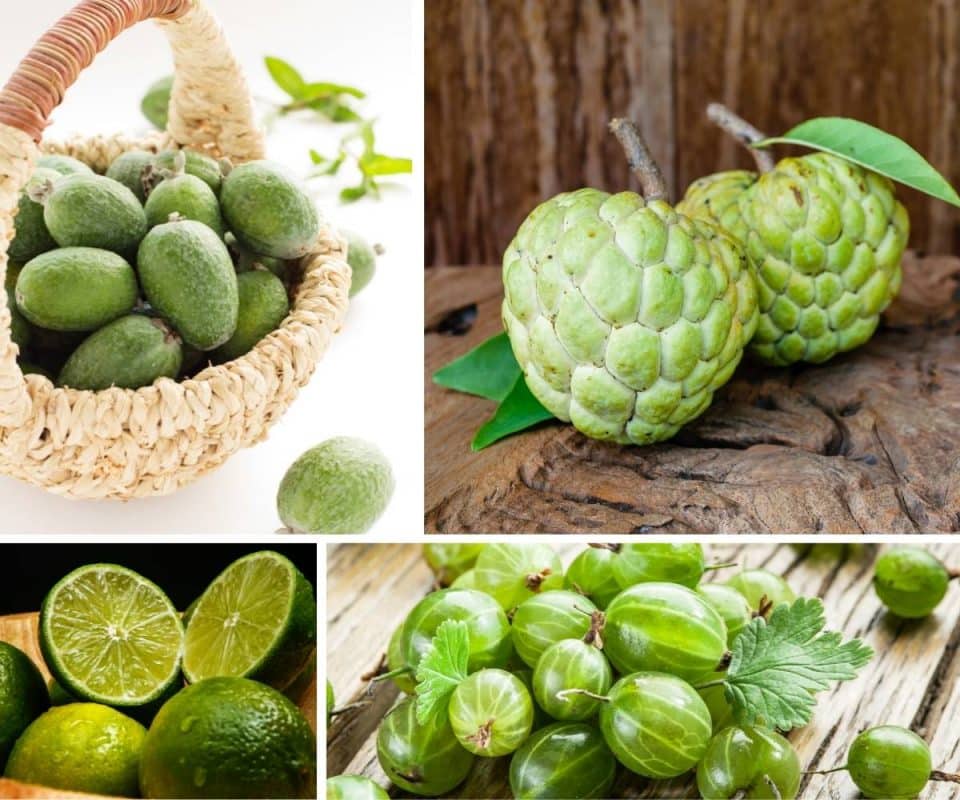20 Naturally Pink Fruits (with Pictures!)

If you’re considering a color-themed celebration, pink fruits can provide an easy splash of color to your party buffet! From delicate blush pinks to deep fuchsias, there’s a surprisingly wide range of options to choose from that will add effortless girly glamor.
Or perhaps you’re just looking for attractive and surprising additions to liven your fruit bowl or fruit salads? It’s astonishing how many everyday fruits are available in pink variations on our familiar favorites.
In this article, we take a look at the most beautiful, the most unexpected, and the most nutritious pink fruits. Are there any pink fruits that haven’t made it onto our list but deserve a place? Let us know in the comments below!
1. Pink Lemonade Blueberries

The tiny bursts of flavor have the best name. They’re much sweeter than ordinary blueberries, with an incredible lemony tang.
These tiny gems can be enjoyed alone or added to fruit salads, and offer an exciting twist to baked goods, yogurts, and desserts. In addition, pink lemonades won’t stain your fingers or kitchen surfaces.
They’re also packed with the same potent antioxidants as blueberries and provide high levels of vitamins C and K, fiber, and manganese. What’s not to love?
2. Pink Bananas

Known as the prettiest bananas in the world, pink bananas are much daintier than their everyday yellow cousins.
While they are edible, these shocking pink finger-length beauties are probably best used to add an unexpected artistic touch to your fruit bowl. Why? Because not only is their flesh covered in tiny hairs (they’re sometimes known as velvet bananas), each banana contains up to 40 inedible seeds.
So they’re probably best used for ornamentation – while you get your nutrients and snacking pleasure from the good old yellows.
3. Rhubarb

The color of rhubarb stalks can be anything from rosy pink to deep crimson. On its own, rhubarb is, to be frank, very sour. But when cooked with sugar and partnered with sweet sauces, ice creams, or baked in pies and crumbles, the tartness becomes a thing of wonder. It’s an excellent accompaniment for pork, game, or other rich meats.
Rhubarb contains vitamins C and B-complex, fiber, calcium, and potassium. In addition, it’s reputed to support weight loss due to its power to boost the metabolism.
Caution! Never eat rhubarb roots or leaves, as they’re highly toxic. Instead, stick to the stalks and you’ll be just fine.
4. Dragon Fruit

Pink pitayas, also known as dragon fruits or strawberry pears, are famous worldwide for their vibrant fuchsia skin, weird green spikes, and blush-pink pulp. Their flavor is comparable to watermelon or pears.
You can add dragon fruits to fruit salads, make smoothies and desserts, or bring out your inner dragon and feast on them as an unusual, healthy treat.
These exotic fruits are packed with antioxidants.
5. Guava

These small, plum-like fruits have green skin and bright pink pulp studded with tiny edible seeds. As they’re sweet and juicy, you can enjoy guavas as a snack (peel them first), add to fruit salads, or use them to make pastes, jellies, or ice creams.
They have a flowery aroma and a taste somewhere between strawberries and pears. Guavas are a common ingredient in Paraguayan, Colombian desserts and other South American cuisines.
Guavas are incredibly nutritious. Each one contains five times as much vitamin C as that found in a medium orange. They’re also high in vitamins A and B1. No wonder Bob Marley wrote a song about them!
6. Lychees

The lychee is a juicy, sweet fruit with a slight floral perfume. The crimson ‘crocodile’ skin peels away easily with a thumbnail to reveal the succulent blush-pink or white pulp and dark shiny seed hidden within.
The flavor is delicate – while some say it resembles grapes or strawberries, others detect notes of pear or watermelon.
Like all pink fruits, they contain valuable nutrients. A single lychee provides around 9% of the recommended daily intake. They also contain copper and potassium, two minerals essential for heart health.
7. Hidden Rose Apples

How did hidden rose apples get their name? Their yellow skin has a pinkish blush marked with pale dots. What makes them astonishing is the deep rose-red flesh hidden beneath. It’s crunchy and firm, providing a perfect sweet-tart balance.
They retain their firmness when cooked, making them a colorful choice for pies, cobblers, and sauces.
Hidden rose apples are loaded with fiber, potassium, vitamins A, C, E, and K, calcium, phosphorus, magnesium, iron, and copper, making a nutritious snack.
8. Pink Satin Pomegranates

Pomegranates are the perfect blend of sweet and sour. Foodies and clean eaters acknowledge them as a versatile superfood and they are commonly used in desserts and even salads, especially in the Middle East.
With a flavor resembling cranberries, they’re packed with tiny glistening gems, each bursting with delicious juice. One benefit of the pink satin variety is that the seeds are virtually unnoticeable.
Pomegranates are low in calories and fat and rich in fiber, vitamins, and minerals. You’ll get the best nutritional benefits by eating the seeds, or arils, inside.
9. Rainier Cherries

While plenty of cherries have pink skins, we’ve chosen Rainiers because they’re a little different – and gorgeously succulent. Naturally big and super-sweet, they have yellow skins with a pink blush. Inside, the flesh is yellow, with pink streaks.
They have a floral aroma with notes of peaches and a caramel-like aftertaste.
Rainier cherries contain vitamins A and C and are a valuable source of potassium, copper, and manganese.
10. Rosé Strawberries

At first glance, pink rosé strawberries look like unripe strawberries. Which they’re not. They’re a cross-bred variety with a far more intense flavor than regular supermarket strawberries.
They’re sweet-tart, with subtle notes of peach and flowers, so use them in the same way as strawberries, and enjoy that old-fashioned strawberry taste.
11. Pink Muscat Grapes

Muscat grapes are renowned for their sweet, musky flavor and delectable floral perfume. They make lovely sweet wines and are dried to create fat, juicy raisins.
In addition to their attractive and unusual skin color (muscats are typically yellowy-green), pink muscat grapes have a significant advantage – they’re seedless.
This makes them easier to snack on or add to other dishes without the need to spit out the seeds or the dilemma of disposing of them elegantly.
12. Pink Glow Pineapple

Are you looking for something to make your Instagram feed pop? Or need to freshen up the look of your boring pina coladas? Pink glow pineapples could be your answer.
Produced in Costa Rica by a single grower, these trademarked, genetically modified fruits take up to 2 years to reach maturity. So if you can get your hands on one, expect to pay a premium!
On the plus side, they look fantastic, and they’re juicier than their yellow cousins.
While they have a similar nutrient profile to other pineapples, let’s face it – that’s not why you’ll buy one!
13. Pink Pearl Apples

Sweet, sharp, and crispy with a weird yellow skin that’s almost translucent and pink on the inside – that describes pink pearl apples.
While they’re great as a raw snack or in salads, they’re also fantastic in baked goods, such as open-topped tarts, or in sauces where their pink color can make an impact.
14. Rambutans

Despite their knobbly skin, rambutans are easy to peel and eat. They’re sweet and juicy, resembling grapes or lychees.
Although they’re typically eaten raw, the pulp can make a delicious topping for ice creams and yogurts.
Like many tropical fruits, rambutans have potent health benefits. As well as fiber, they contain high levels of vitamins A and C, zinc, and calcium.
15. Pink Pomelos

Contrary to popular belief, pomelos are not the result of crossing a grapefruit with something else. They’re one of a few genuinely wild citrus fruits. Pomelos became the ancestors of grapefruits when they were first crossed with oranges.
Pink pomelos have been developed to be sweeter and less bitter than their wild relatives. They’re typically enjoyed raw, though they make excellent preserves and dessert toppings. A pinch of cinnamon can bring out their flavor. Their zest can also be used, like any other citrus.
One pomelo contains several days’ vitamin C supply and offers other vitamins and minerals.
16. Pink Lady Apples

It’s no surprise they’re one of the most popular varieties in the world. Pink Lady apples are crisp, with a sweet-sharp flavor and a slight citrus tang. As the name suggests, the skin is a true pink, but the flesh is brilliant white.
They’re very versatile and can be used for snacking, salads, baking, and cooking.
Like all apples, they’re packed with fiber and contain valuable quantities of vitamins A and C and a range of minerals.
17. Pink Grapefruit

Pink grapefruit is prized for the balance between sweetness and its bitter aftertaste.
Because of its attractive color, you’ll find pink grapefruit recipes everywhere. This versatile fruit can add interest to sorbets, salads, energy bars, cocktails, smoothies, and more.
Grapefruit delivers essential nutrients. Just half of a pink grapefruit provides 100% of vitamin C and 35% of vitamin A in recommended daily amounts.
18. Chinese Bayberry

These sweet and juicy raspberry-pink fruits are around ½ inch in diameter, with a small stone in the center. In China, they’re known as Yangmei berries.
As they have a short shelf life, you’re more likely to find their juice in specialty stores marketed as Yumberry.
These sweet fruits contain all the B and C vitamins you’d expect. But bayberries also have high levels of a mighty group of antioxidants called OCPs. These are 20 times as powerful as vitamin C and 50 times as powerful as vitamin E. Wow! So if you want your fruit to deliver powerful health benefits, bayberries are worth looking out for!
19. Lilly Pilly Berries

These tiny berries have glossy skin ranging from pink-red to brilliant magenta. Each of the many varieties has its own flavor, so can be sweet-tart, musky, or metallic, sometimes with notes of fruits and spices.
Aboriginal Australians call them “medicine berries” and use them to help colds and infections. This makes sense as they contain such high levels of vitamin C, anthocyanins, folate, and calcium.
20. Prickly Pears

The inside of ripe pink prickly pears is soft, sweet, and juicy. Their fragrance evokes melons, kiwis, and even bubblegum.
Prickly pear fruit is an excellent source of vitamin C, calcium, fiber, kaempferol, and various antioxidants.
If you enjoyed this article, check out our story about popular pink foods.

Related: Add These 21 Green Fruits to Your Diet

Related: 20 Tasty Yellow Fruits

Related: 20 Stunning Blue Fruits


